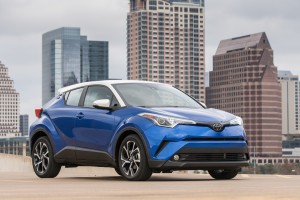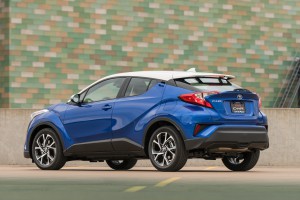
The 2018 Toyota C-HR is designed to appeal to younger buyers looking for fuel efficiency and utility.
Conventional wisdom suggests American consumers don’t have much use for small vehicles — except for small crossover utility vehicles, and that is an awful big exception as carmakers move to offer new models that are certain to attract new buyers into small vehicles.
The 2018 Toyota C-HR, for example, was originally designed to fit into the automaker’s Scion line. But with Scion’s demise, Toyota expects the newest vehicle in its portfolio to appeal the youthful demographic of 20- and 30-something buyers with its contemporary styling, sophisticated technology, fuel-efficient performance, maneuverability and overall utility.
The new C-HR was also designed as global vehicle – the one coming to the U.S. will be assembled in Turkey – It is built around one of Toyota’s new modular architectures and was basically can fit into heavy traffic anywhere or out onto back roads in Europe and North America.
A test drive through the countryside in the heart of Texas underscored the robust character of the C-HR’s new chassis, which was stiff enough to give the vehicle a sport vehicle feel but rugged enough to manage dips and potholes without much of a fuss.
The steering was quite accurate and the brake feel and stopping power – an area where Toyota has come up short in recent years – was quite good. Overall, the ride and handling, particularly its grip on the road through curves, was very competent for a vehicle with a relatively short wheelbase of 103.5 inches.
(Toyota C-HR makes debut in Los Angeles. Click Here for the story.)
Besides its overall maneuverability, the C-HR – the initials stand for coupe high rider, which is something of misnomer since has four doors – comes with fresh take on traditional hatchback styling to reach out to younger buyers, looking for utility vehicle. The C-HR still has the distinctive Toyota front fascia that features two slim projector-beam halogen headlights with LED daytime running lights cut into the front quarter panels.
Toyota’s designers like to describe the C-HR’s overall appearance as “sexy, muscular and edgy.” The front fascia of the C-HR is set off by a long hood, a clean profile that looks taller than it is and an uncluttered rear lift gate. Toyota stylists also have worked to design some character into the four corners of the vehicle with carefully cut shapes so the C-HR appearance is more coherent and more appealing than some of the designs that have rolled out of Toyota studios in recent years.
On the inside, Toyota has moved away from the hard plastic, though not entirely. But the key interior faces are covered soft material at key places and different textures are used throughout the cabin, giving the interior a bit of character. In addition, the instrument panel functional and the controls are laid out nicely, giving the cabin a functional feel.
The cabin is relatively quiet for a small vehicle in subcompact wheel base and a 70.7-inch track and is a little over five-feet tall. But it is fairly room on the inside and can carry up to five passengers in a pinched and the rear seats fold down to produce a flat load floor.
The C-HR is powered by a 2.0-liter engine that was honed, according to the chief engineer, on the famed Nürburgring in Germany. The engine will deliver 144 horsepower and 139 foot pounds of torque and is matched with a new CVT-type transmission.
(Toyota puts old headquarters on the market. Click Here for the story.)
Overall, the powertrain responsive and when the gas pedal is down it gets up to highway speed efficiently, opening the door for passing or moving up to highway speed but there is no all-wheel-drive system. Fuel economy is rated 27 miles per gallon in the city or 31 mpg on the highway for a combined rating of 29 mpg.
The C-HR will be available in two grades at launch, XLE and XLE Premium, each equipped with standard features that include 18-inch alloy wheels, dual-zone climate control, supportive bucket seating, 7-inch audio display, and Toyota’s Safety Sense system with pre-collision braking and pedestrian detection. Prices start at $22,500 for the XLE plus a $960 destination charge.
Standard features in the XLE include a premium leather steering wheel; power fold and heated mirrors; auto-dimming rearview mirror with backup camera; electric parking brake; and dual-zone climate control.
The XLE Premium, with a price tag of $24,350 before the destination is applied, incorporates the XLE’s amenities and adds Blind Spot Monitor and Rear Cross Traffic Alert; heated front seats; power lumbar driver’s seat; auto fold, heated side mirrors with puddle lamps that project “Toyota C-HR”; fog lamps; and Smart Key with push button start. Both grades are equipped with a 7-inch touch screen display having AM/FM/HD Radio, Aha app, USB port and AUX jack, Bluetooth and voice recognition.
Toyota executives are confident that the C-HR will help the company grow its sales volume and while the overall market is facing some uncertainty, their educated guess is probably correct from what I could see.
(Toyota shifting bet from conventional hybrids to plug-ins. Click Here for the story.)
The new C-HR is a small, efficient and utilitarian vehicle that is certain to appeal to younger buyers who have more money in their pocket than ever before but aren’t interested in spending a bundle on a new vehicle. Toyota’s well-established reputation for quality, reliability and durability can only increase the C-HR’s appeal.

